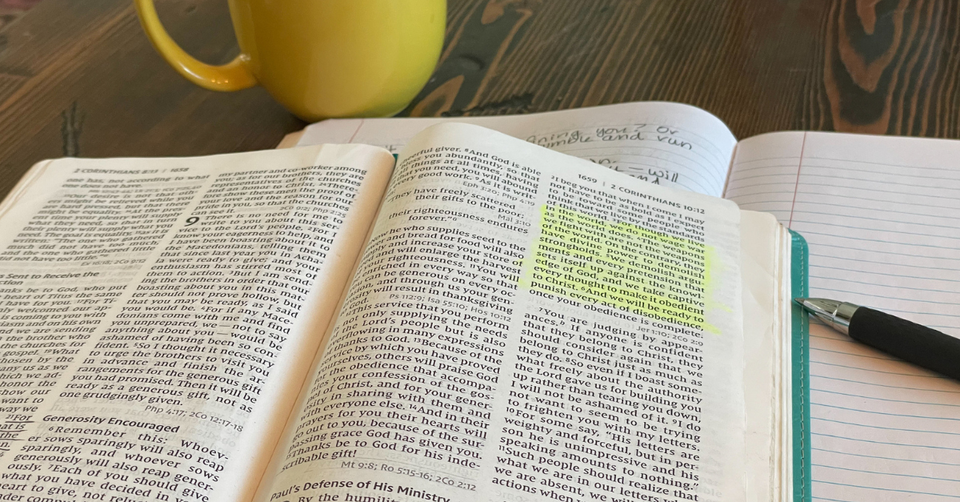14 Techniques to Help You Study the Bible Like the Pros

I think it’s weird, sometimes, that people pay me to study the Bible. Every Christian can open God’s Word and discover truth for life, but I’m part of a group for whom Christianity is not only a religion but also a profession. Theologians, pastors, and seminary professors are paid to be “pros” at studying Scripture.
You don’t have to be a professional to study the Bible like a theologian. There are 14 primary exegetical methods we “pros” use to uncover the truth in Scripture—and you can use them, too! Let’s look at examples from my commentary, Bible-Smart™: Matthew to explore what I’m talking about.
Photo Credit: ©Getty Images/ Dennis Swanson - Studio 101 West Photography

Method #1: Archaeological Insights
Definition:
The study of discoveries from the field of archaeology to reveal insight into references made in the text.
Example:
Matthew 4:12-17 reports Jesus lived with Peter in Capernaum for a while. Archeologists believe they’ve uncovered Peter’s ancient home. It was located only about 80 feet from a synagogue—making it easy for Jesus to speak regularly there.
Resources:
- Biblicalarchaeology.org
- NIV Archaeological Study Bible (Zondervan)
Method #2. Bible Difficulties
Definition:
A logical approach to address so-called “difficult” texts, such as commands to kill, or questionable facts, to arrive at a reasonable explanation for the perceived difficulty.
Example:
Matthew 1:1-17 and Luke 3:23-38 both give genealogies of Jesus—but their lists are different. It’s likely Matthew’s genealogy focuses primarily on the family tree of Jesus’ adopted father, Joseph, while Luke highlights the lineage of his mother, Mary.
Resources:
- The Apologetics Podcast
- 100 Tough Questions about God and the Bible by Stephen M. Miller (Bethany House)
- CSB Apologetics Study Bible (Holman Bible Publishers)
Method #3: Cross-Reference Comparisons
Definition:
When Scripture is used to interpret the Scripture.
Example:
What does “outer darkness” mean? That phrase appears only three times in the New Testament, in Matthew 8:12; 22:13; and 25:30. By comparing those cross-references, we discover that Jesus uses it as a reference to hell in every instance. Thus, viewing “outer darkness” as a symbolic synonym for hell is safe.
Resources:
- Bible Cross-Reference Search
- The New Strong's Expanded Exhaustive Concordance of the Bible (Thomas Nelson)
Method #4: Cultural Commentary
Definition:
Insights into meaning within a text are drawn from factors related to the culture of the place and time in which the text was written.
Example:
Why was Jesus so adamant about mentioning “the right cheek” when he commanded followers to “turn the other cheek” in Matthew 5:38-42? Striking a person on the right cheek required a backhanded slap. In that culture, a backhanded slap was an egregious insult communicating utter contempt toward an inferior person. In other words, Jesus was saying that even the worst insult should be forgiven.
Resources:
- The IVP Bible Background Commentary 2-Volume Set (IVP Academic)
- Zondervan Illustrated Bible Backgrounds Commentary 9-Volume Set (Zondervan)

Method #5: Factual Info
Definition:
To reference information such as weights, measures, currencies, facts, and figures to enhance understanding of textual references.
Example:
In Matthew 25:14-30, Jesus tells a parable of a man who gives “talents” of money to three servants. A talent of silver was equivalent to about 6,000 days of wages. So, the servants received anywhere from twenty years of wages to almost a hundred years’ worth of income to manage!
Resources:
- BibleInfo.com
- The Baker Illustrated Bible Handbook (Baker Books)
Method #6: Geographical Backgrounds
Definition:
To utilize a text’s real-world location and architecture to aid in understanding physical context and environmental references.
Example:
In Matthew 7:13-14, Jesus refers to a “broad road” and a “narrow road.” His hearers would’ve immediately understood a “broad road” to be emblematic of the large, well-kept Roman thoroughfares that could accommodate all kinds of merchant and tourist traffic and legions of soldiers. A “narrow road” would’ve suggested difficult-to-traverse mountain pathways used by local travelers and avoided by outsiders.
Resources:
- Online Bible Atlas Links (https://www.godweb.org/atlasindex.htm)
- Discovery House Bible Atlas by Dr. John A. Beck (Our Daily Bread Publishing)
Method #7: Historical Backgrounds
Definition:
Insights into the text are drawn from factors related to historical events and circumstances.
Example:
Matthew 2:13-18 records that King Herod ordered the murder of helpless infants in and around Bethlehem. The atrocity seems so repugnant, and impossibly cruel. Can we believe it really happened? Historical sources reveal this king was known for being murderous, emotionally disturbed, maniacally paranoid, and possibly insane. He killed two of his sons, his wife, and many others in his court and extended family. Roman emperor Caesar Augustus once said it was “better to be Herod’s pig than his son.” The Jewish king didn’t eat pork, and pigs in his household were never butchered. So, sadly, it is historically believable Herod could order the slaughter of innocents in Jesus’ time.
Resources:
- Bible-History.com
- Jesus and His Times (Reader’s Digest Books)
Method #8: Inductive Studies
Definition:
The use of logical reasoning to make broad generalizations based on specific observations.
Example:
Jesus provides the classic illustration of inductive reasoning in his commentary on Exodus 3:6, as recorded in Matthew 22:31–32. Starting with the specific observation of present-tense verb usage in Exodus 3:6, “I am the God of Abraham, the God of Isaac, and the God of Jacob,” Christ reasons God “is not the God of the dead but of the living.” In this way, he proves to the Sadducees there will be a resurrection of the dead.
Resources:
- Inductive Bible Study Walkthrough
- ESV New Inductive Study Bible (Harvest House Publishers)
Photo Credit: ©GettyImages/AndreyPopov

Method #9: Literary Influences
Definition: An exploration of literary structure and writing styles to intuit meaning and intent from a text.
Example: The entire gospel of Matthew is an example of literary influence. Written primarily for a Jewish audience, it is uniquely Hebrew in the literary sense. Matthew wrote nearly every moment of Jesus’ life in terms of Old Testament prophecies and promises about the coming Messiah. This gospel includes over fifty clear quotations from Old Testament texts, beginning with a quote from Isaiah 7:14 in Matthew 1:23, “The virgin will conceive a child...”
Resources:
- Welcome to BibleWorld (The Good Book Co.)
- A Complete Literary Guide to the Bible (Zondervan)
Method #10: Personality and Character Studies
Definition: Analysis of the life and actions of a specific person in Scripture to gain insight into living from that person.
Example: Jesus’ stepfather, Joseph, plays a prominent role at the beginning of the gospels, then seems to disappear. Still, his influence in the lives of Mary and Jesus—and thus, on the Christian faith—is impossible to ignore. What can we learn from his example? Compassion for the vulnerable (Matthew 1:19), immediate obedience to God (Matthew 1:24; 2:14, 21), and faithful devotion to God and his commands (Matthew 1:19, Luke 2:21-41).
Resources:
- People of the Bible Archive (https://www.christianity.com/bible/people-of-the-bible/archive/)
- National Geographic Who's Who in the Bible (National Geographic)
Method #11: Rhetorical Influences
Definition: A study of persuasive techniques and aims displayed in the way a text was written.
Example: In Matthew 18:9 Jesus makes some extreme statements, such as, “If your hand or your foot causes you to stumble, cut it off…” Some have tried to interpret this literally, but it’s an example of a rhetorical device called hyperbole. That is, obvious exaggeration to evoke an emotional response—something Christ did on several occasions (see Matthew 6:3 and Luke 14:26–27, among others).
Resources:
- Rhetoric – Holman Bible Dictionary
- New Testament Rhetoric, Second Edition by Dr. Ben Witherington III (Cascade Books)
Photo Credit: Getty Images/Radu Bighian

Method #12: Symbolic Meanings
Definition: To impute meaning into a text by applying representational dynamics, that is, using substitutes to represent ideas, qualities, people, things, events, etc.
Of all methods of biblical study, this one is the most likely to be abused, as evidenced by much of Christian history. Tread carefully when applying symbolism to a passage of Scripture.
Example: Matthew 2:1-12 records the visit of the Magi to Jesus when he was a baby. Why did they give such strange gifts? Likely because of their symbolic value: gold symbolized royalty and nobility; frankincense symbolized worship; and myrrh symbolized death and suffering. Together the gifts symbolized the passion, purpose, and Person of our Christ.
Resources:
- BibleSymbol.com
- Dictionary of Biblical Imagery (IVP Academic)
Method #13: Theological Commentary
Definition: To explore the meaning of a text considering its relation to bigger-picture ideas of orthodoxy and doctrine.
Example: In Matthew 9:1-8 Jesus heals a paralytic by making a theological statement: “Your sins are forgiven.” According to Jewish theology, God alone could forgive sin—meaning Jesus made a claim to be equal with God. This was considered blasphemy, but Jesus proved his claim by performing a miracle: instantly healing the paralyzed man. Thus, when we declare Jesus is both the Son of God and God himself, we agree with the theology Christ first displayed and articulated in moments such as Matthew 9:1-8.
Resources:
- Systematic Theology by Dr. Louis Berkhof (Martino Fine Books)
- Brazos Theological Commentary on the Bible 29-Volume Set (Brazos Press)
Method #14: Word Studies
Definition: To take a deeper look at the meaning, background, and usage of keywords present in the text.
Example: “Be perfect, therefore, as your heavenly Father is perfect,” Jesus said in Matthew 5:48. In our 21st Century experience, we tend to define “perfect” as “flawless”—but the Greek word for perfect, teleioi, carries a different connotation. Instead of “flawless,” it means “finished” or “mature.” So, when Jesus tells us to “be perfect,” it’s primarily a call for us to participate in a Holy Spirit-cultivated growth process by which we continually become more “mature” or “finished” in faith and life.
Resources:
- Interlinear Bible: Greek, Hebrew, Strongs
- The Hebrew-Greek Key Word Study Bible (AMG Publishers)
Photo Credit:©GettyImages/Justin Kendra
Originally published April 12, 2023.








